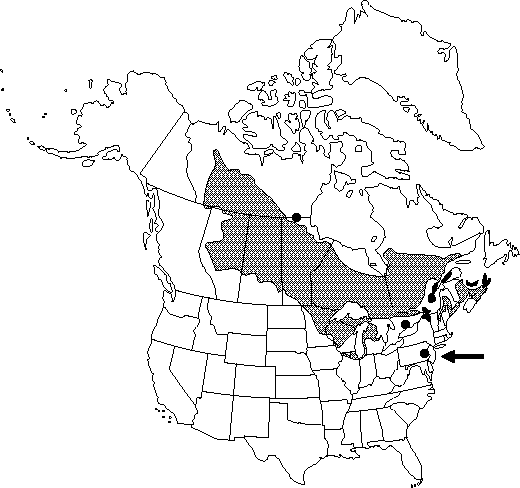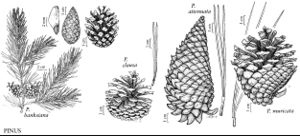Pinus banksiana
Descr. Pinus 1: 7, plate 3. 1803.
Trees to 27m; trunk to 0.6m diam., straight to crooked; crown becoming irregularly rounded or spreading and flattened. Bark orange to redbrown, scaly. Branches descending to spreading-ascending, poorly self-pruning; twigs slender, orange-red to redbrown, aging gray-brown, rough. Buds ovoid, redbrown, 0.5–1cm, resinous; scale margins nearly entire. Leaves 2 per fascicle, spreading or ascending, persisting 2–3 years, 2–5cm × 1–1.5 (–2) mm, twisted, yellow-green, all surfaces with fine stomatal lines, margins finely serrulate, apex acute to short-subulate; sheath 0.3–0.6cm, semipersistent. Pollen cones cylindric, 10–15mm, yellow to orangebrown. Seed-cones maturing in 2 years, shedding seeds soon thereafter or often long-serotinous and shedding seeds only through age or fire, upcurved, asymmetric, lanceoloid before opening, ovoid when open, 3–5.5cm, tan to light-brown or greenish yellow, slick, nearly sessile or short-stalked, most apophyses depressed but increasingly mammillate toward outer cone base; umbo central, depressed, small, sunken centrally, unarmed or with a small, reflexed apiculus. Seeds compressed-obovoid, oblique; body 4–5mm, brown to near black; wing 10–12mm. 2n =24.
Habitat: Fire successional in boreal forests, tundra transition, dry flats, and hills, sandy soils
Elevation: 0–800m
Distribution

Alta., B.C., Man., N.B., N.W.T., N.S., Ont., P.E.I., Que., Sask., Ill., Ind., Maine, Mich., Minn., N.H., N.Y., Pa., Vt., Wis.
Discussion
Pinus banksiana reaches its largest size and best form in Canada. In western Alberta and in northeastern British Columbia, it is sympatric with P. contorta and forms hybrid swarms with that species.
Jack pine (Pinus banksiana) is the territorial tree of the Northwest Territories.
Selected References
None.
Lower Taxa
"relatively thin" is not a number.
